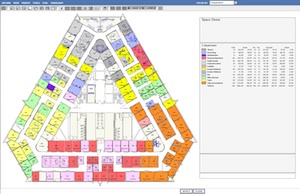

Expanding its applications for spatial modeling past the construction phase of the building lifecycle, Trimble, Sunnyvale, Calif., announced August 19 that it will acquire London-based Manhattan Software, a maker of facilities-management and real-estate-management software. Trimble says will take a 100% stake of Manhattan Software and integrate it into its Trimble Buildings Group. The acquisition price was not disclosed.
Manhattan Software's offerings include its Integrated Workplace Management System, which allows for planning and management of real estate portfolios, and CenterStone Computer-Aided Facilities Management, a building-usage planning and management application for facilities managers.
Trimble sees benefits of expanding its offerings beyond design and construction. "From our current solutions footprint in the AEC world, we can leverage that deep information gained throughout those processes into the facility's ongoing operation through the footprint of Manhattan Software," said John Leet, Trimble Buildings marketing vice president.
"Trimble is very strong in the areas of planning, design and building. We think we can complete that lifecycle on the operational side," says Craig Gillespie, CEO of Manhattan Software. "The things people have been asking for are found in Trimble's technolgy: indoor positioning, building-information modeling, GIS, analytics."
The acquisition of Manhattan Software is in line with other Trimble acquisitions in recent years, including SketchUp and Tekla, says Trimble's Leet. "[Those acquisitions] were in the construction phase. Manhattan represents the cornerstone of our expansion into the building, owner, operator space … the cornerstone of our ability to extend the data into the ongoing operation of facilities and buildings."
While Trimble has not specified how Manhattan Software's offerings will be integrated into its existing design and construction platforms, initial efforts may focus on the handover process to owners and operators, says Geene Alhady, general manger of Trimble Building's owner/occupier division. "We see growth for spatial tech in building interiors, and how those interior spaces defined in 3D can be mined and those valuable data sets can be driven by BIM-type technology. The result will be a greater value for buildings and other assets."
While Trimble representatives would not say how the company's design and construction software may change to reflect the new offerings, Leet did add that Trimble would be reevaluating their existing products to see how their data may benefit real estate and facilities management customers. "I think the real estate and facilities management industry will evolve and be able to package and leverage that information," he says.
"I believe that Trimble is quite unique in our strategy here," says Alhady. "We're combining the technology in this market, and we believe we are quite innovative in this area, as we are addressing new challenges in the market."



Post a comment to this article
Report Abusive Comment